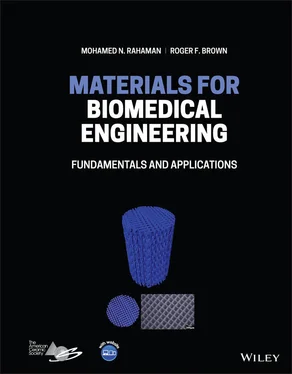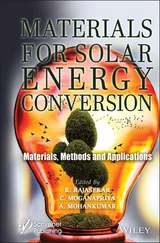Mohamed N. Rahaman - Materials for Biomedical Engineering
Здесь есть возможность читать онлайн «Mohamed N. Rahaman - Materials for Biomedical Engineering» — ознакомительный отрывок электронной книги совершенно бесплатно, а после прочтения отрывка купить полную версию. В некоторых случаях можно слушать аудио, скачать через торрент в формате fb2 и присутствует краткое содержание. Жанр: unrecognised, на английском языке. Описание произведения, (предисловие) а так же отзывы посетителей доступны на портале библиотеки ЛибКат.
- Название:Materials for Biomedical Engineering
- Автор:
- Жанр:
- Год:неизвестен
- ISBN:нет данных
- Рейтинг книги:4 / 5. Голосов: 1
-
Избранное:Добавить в избранное
- Отзывы:
-
Ваша оценка:
- 80
- 1
- 2
- 3
- 4
- 5
Materials for Biomedical Engineering: краткое содержание, описание и аннотация
Предлагаем к чтению аннотацию, описание, краткое содержание или предисловие (зависит от того, что написал сам автор книги «Materials for Biomedical Engineering»). Если вы не нашли необходимую информацию о книге — напишите в комментариях, мы постараемся отыскать её.
A comprehensive yet accessible introductory textbook designed for one-semester courses in biomaterials Materials for Biomedical Engineering: Fundamentals and Applications
Materials for Biomedical Engineering: Fundamentals and Applications
Materials for Biomedical Engineering — читать онлайн ознакомительный отрывок
Ниже представлен текст книги, разбитый по страницам. Система сохранения места последней прочитанной страницы, позволяет с удобством читать онлайн бесплатно книгу «Materials for Biomedical Engineering», без необходимости каждый раз заново искать на чём Вы остановились. Поставьте закладку, и сможете в любой момент перейти на страницу, на которой закончили чтение.
Интервал:
Закладка:
12 Index
13 End User License Agreement
List of Tables
1 Chapter 1 Table 1.1 Key applications of synthetic materials and modified natural mate...
2 Chapter 2 Table 2.1 Scales of structure in solids. Table 2.2 Bonding energy and melting temperature of various substances. Table 2.3 Calculated stiffness and Young’s modulus (the elastic modulus in ... Table 2.4 The α‐amino acids of proteins. Table 2.5 Measured amino acid content of human tendon. Table 2.6 Summary of the four levels of protein structure and major atomic ...
3 Chapter 3 Table 3.1 Atomic packing fractions of the simple cubic, body‐centered cubic... Table 3.2 Crystal structure and atomic radius of some common metals at room... Table 3.3 Characteristic properties of the three common metallic structures...
4 Chapter 4 Table 4.1 Mechanical properties of selected materials used as biomaterials.
5 Chapter 5 Table 5.1 Common methods for the surface chemical analysis of materials.
6 Chapter 6 Table 6.1 Biomedical applications of metals. Table 6.2 Composition and mechanical properties of four cobalt−chromium all...Table 6.3 Composition and mechanical properties of degradable magnesium all...
7 Chapter 7Table 7.1 Biomedical applications of ceramics, glasses, and glass‐ceramics.Table 7.2 Major properties of main calcium phosphate compounds relevant to ...Table 7.3 Nominal composition (in wt%) of two common glasses and some bioac...Table 7.4 Composition of parent glass and properties of lithium disilicate ...
8 Chapter 8Table 8.1 Common nondegradable synthetic polymers used as biomaterials and ...Table 8.2 Data for some common polymers available commercially for use as b...Table 8.3 Effect of crosslinking and crystallinity on mechanical properties...
9 Chapter 9Table 9.1 Degradable synthetic polymers used or investigated for use as bio...Table 9.2 Physical properties of poly(α‐hydroxy esters) and polycaprolacton...Table 9.3 Typical properties of poly‐3‐hydroxybutyrate (P3HB) and its copol...
10 Chapter 10Table 10.1 Comparison of the Young’s modulus of collagen at multiple hierar...Table 10.2 Approximate mechanical properties of some protein‐based polymers...
11 Chapter 11Table 11.1 Examples of polymers used to create hydrogels for biomedical app...
12 Chapter 13Table 13.1 Examples of chemical and physicochemical methods used to modify ...Table 13.2 Examples of biomolecules that may be immobilized on or within po...
13 Chapter 14Table 14.1 Standard electrode potentials ( E o) at 25 °C and 1 atm. aTable 14.2 Ionic concentration of plasma.Table 14.3 Organic and protein constituents of plasma.
14 Chapter 16Table 16.1 Biochemical compositions (in weight percent) of three different ...Table 16.2 Selected growth factors and cytokines: source, target tissues, a...Table 16.3 Summary of cell types involved in biocompatibility phenomena and...
15 Chapter 18Table 18.1 Cells, molecules, and other entities involved in the inflammator...
16 Chapter 21Table 21.1 Topographical characteristics of the cicada ( Tibicen ssp.) and...
17 Chapter 23Table 23.1 Applications of biomaterials in fracture fixation.Table 23.2 Types of bone grafts and their characteristics.Table 23.3 Examples of bone graft substitutes composed of biomaterials.
18 Chapter 24Table 24.1 Types of materials used for common sutures.Table 24.2 Types of contact lens.
19 Chapter 25Table 25.1 Main types of cells used in tissue engineering to regenerate var...Table 25.2 Constituents of culture media used for ex vivo tissue engineering...Table 25.3 Prominent growth factors used in tissue engineering for the rege...Table 25.4 Examples of polymers used as scaffolds in the form of porous sol...Table 25.5 Examples of polymers used as scaffolds in the form of hydrogels,...
20 Chapter 26Table 26.1 Different routes of drug delivery, their main advantages and dis...Table 26.2 Examples of overexpressed tumor receptors, locations, and target...Table 26.3 Examples of copolymers used to form polymersomes.Table 26.4 Examples of polymer–protein and polymer–drug conjugates develope...
List of Illustrations
1 Chapter 1 Figure 1.1 Examples of biomaterials in use for medical and dental applicatio... Figure 1.2 Schematic showing the major components of the biomaterials field.... Figure 1.3 Schematic of the classes of materials used as biomaterials, along... Figure 1.4 Stages in the evolution of the intravascular stent, used as an ex... Figure 1.5 Strength versus elastic modulus for the three major classes of sy... Figure 1.6 Illustration of (a) the human hip joint and (b) an artificial hip... Figure 1.7 Image showing the components of an artificial implant used for to... Figure 1.8 Various combinations of materials currently used in implants for ... Figure 1.9 Illustrative summary of the evolution of biomaterials classified ...
2 Chapter 2 Figure 2.1 Schematic illustration of the formation of (a) ionic bond, (b) co... Figure 2.2 Schematic illustration of covalent bonding in the hydrogen molecu... Figure 2.3 Formation of an interatomic bond viewed in terms of (a) interatom... Figure 2.4 Relationship between interatomic force versus displacement curve ... Figure 2.5 Illustration of (a) nonpolar bond in hydrogen molecule (H 2) and (... Figure 2.6 Schematic illustration of the formation of four sp 3orbitals in (... Figure 2.7 Schematic comparison of the directionality of sp, sp 2, and sp 3hy... Figure 2.8 Schematic illustration of covalent bonding in methane, ammonia, a... Figure 2.9 Illustration of the formation and geometry of single, double, and... Figure 2.10 Illustration of covalent bonds linking carbon atoms (C) in the c... Figure 2.11 Schematic comparison of the attractive interactions in the ionic... Figure 2.12 Illustration of the interactions in van der Waals bonding: (a) d... Figure 2.13 Illustration of (a) polarity of each covalent bond in the trichl... Figure 2.14 Schematic illustration of hydrogen bonds between water molecules... Figure 2.15 Illustration of the arrangement of water (H 2O) molecules in ice ... Figure 2.16 Schematic comparison of (a) van der Waals bonding between nonpol... Figure 2.17 Side groups in 20 naturally occurring α‐amino acids which can be... Figure 2.18 Illustration of (a) condensation reaction between two amino acid... Figure 2.19 Schematic illustration of the stereochemistry of the amide bond.... Figure 2.20 Illustration of (a) α‐helix structure generated by intrachain hy... Figure 2.21 Illustration of β‐sheet structure generated by layering of polyp... Figure 2.22 Schematic illustration in two dimensions of the overall three‐di... Figure 2.23 Illustration of the main types of interactions between side grou... Figure 2.24 Illustration of chain folding of protein to form a globular thre... Figure 2.25 (a) Illustration of single α‐chain composed of the amino acid se... Figure 2.26 Schematic illustration of the structure of the modified amino ac... Figure 2.27 Illustrative example of quaternary structure of a protein compos...
Читать дальшеИнтервал:
Закладка:
Похожие книги на «Materials for Biomedical Engineering»
Представляем Вашему вниманию похожие книги на «Materials for Biomedical Engineering» списком для выбора. Мы отобрали схожую по названию и смыслу литературу в надежде предоставить читателям больше вариантов отыскать новые, интересные, ещё непрочитанные произведения.
Обсуждение, отзывы о книге «Materials for Biomedical Engineering» и просто собственные мнения читателей. Оставьте ваши комментарии, напишите, что Вы думаете о произведении, его смысле или главных героях. Укажите что конкретно понравилось, а что нет, и почему Вы так считаете.












